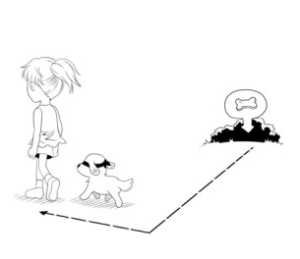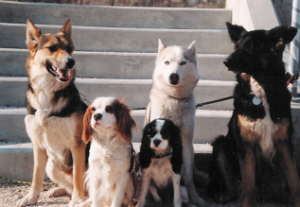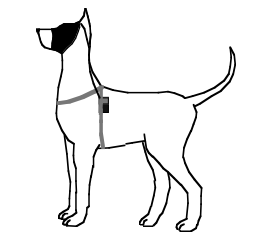
Fig. 1: Courtesy Vanessa Woods and Brian Hare ‘The Genius of Dogs’
Vanessa Woods and Brian Hare surprised me the other day with the drawing they had published in their book ‘The Genius of Dogs’, about one of the experiments I had worked on with the Geneva University in Switzerland (fig.1). I wanted to write about those experiments for a while but other subjects kept popping up and this one kept being pushed back. I love the drawing so much, that I just had to share it.
We often assume that because dogs have an acute sense of smell, they use their olfactory system to find their way around. But when it comes down to it, they have a few other strategies to rely on and will only resort to using their nose as a last resort. One of those strategies, at the basis of all the others, allows them to find their way without using their senses at all, whether visual, auditory or olfactory.
The Psychology Department of Geneva University, Switzerland, had been the teaching ground of Jean Piaget, well known for his work on child cognition. It’s no surprise that research in the Department has been strongly influenced by his work, including in the Ethology laboratory where I worked under the direction of Professor Ariane Etienne. Ongoing studies in the Department have shown that, when you take away the ability of hamsters to rely on any external cues, through manipulations of the environment, they are still capable of finding their nest. Hamsters were guided out of their nest, into a circular arena, towards a location where they could fill their cheek-pouches up with hazelnuts before heading back home. The entire trial happened in complete darkness (infrared light), while white noise was diffused in the lab room and the sawdust covering the arena floor was stirred. For nocturnal animals, this ability was a necessity, especially since they were more vulnerable to predators once slowed down by the extra load from the hazelnuts.

Participating dogs in the experiment
Valerie Seguinot and I decided to test if this ability was also true in dogs (1998). For my Masters degree, I had worked on many different situations testing the dogs’ reliance on different visual cues. But working with dogs is far more challenging than working with hamsters. Just the scale of the experimental room creates a problem so most of my experiments had to be outdoors on soccer fields or in large gymnasiums. There was no possibility of creating a room that was dark enough to prevent the use of visual cues, and spreading sawdust was out of the question. So we resorted to getting the dogs used to blindfolds and earphones that were hooked to a small recorder, attached to a harness, and diffusing white noise. It took us several weeks to get the dogs totally comfortable with the equipment. We were using regular pet dogs and it was critical that they trusted us enough to be able to focus on the task presented and not on the blindfold covering their eyes. We also did not want to stress the dogs so their acceptance of the equipment was a determining factor of whether or not we could even proceed with the experiment.
During the trials, the ground was covered with hundreds of food dummies. They were visually identical to the real treats we were using. They were also stored in plastic bags where they were mixed in with the real treats to soak in some of the smell. The dogs had been exposed to these fake treats and after trying to eat them spit them out. They had learned that they couldn’t find the real one using either their sense of smell or their vision. Equipped with their blindfold and earphones, the dogs were led to a predetermined location where the treat was put under their nose to sniff. The dogs were then led from that point, on an L shaped journey (with different lengths of each section up to 65 ft long), to the location where they were freed from their blindfold and earphones and released to find the bait.
The results of that experiment revealed that, just like hamsters, dogs are capable of finding a specific location without relying on visual, olfactory or auditory cues. The many studies in this field suggest that most if not all animals, from ants to humans are capable of similar results. So the remaining question is: how do they do that?
When information from their senses is unreliable or unavailable, dogs, as well as most other animals, can still use the information derived from their own body, from their own sense of motion. The vestibular system located in their inner ear provides constant feedback about their rotations and accelerations. When walking, they also get information from their body movements. They have an idea of how many steps they took between two points. This of course happens unconsciously, the dogs are not purposely counting how many steps they took. Combining these two sets of information will allow dogs to get a sense of where they came from, like a vector pointing in that direction. Let’s take an example with humans. We’ve all experienced going to a party and walking from one person to the other, chatting here and there as we moved towards the buffet table, at any given time, most of us would still be able to point in the direction of the door we came through, even if it was hidden by the crowd. In further experiments (Cattet & Etienne, 2003) we did with dogs, they were carried and rotated around, thus compromising their ability to process that information. The dogs were no longer able to find the food.
This process is called path integration and is said to be the most primitive navigation system, underlying many of the more complex strategies. Path integration however is mostly valuable on short distances because the longer the animal goes, the more errors he might accumulate. So where it is mostly useful is in combination with the other types of strategies. When an animal can also use landmarks or compasses like the sun, then path integration can confirm their location in relation to one another and also provide a general direction. Research also suggests that path integration could be coupled with the activation of place cells. Together, these neural processes could be determinant in the development of a cognitive representation, or map, of the animal’s surroundings. Place cells are neurones in the hippocampus that will fire as soon as the animal reaches a particular location. In our experiment, it’s likely that path integration provided the dogs a sense of direction and distance to walk, and that place cells contributed in confirming the exact location of the bait.
So it’s not to say that smell does not come into play when it comes to finding their way, but there is more effective and readily available information that dogs will primarily use or that they will use in conjunction with olfactory cues.
Thanks to Vanessa Woods and Brian Hare, I was able to revisit this time in my life where I was testing dogs in the most bizarre situations. The most valuable lesson I learned from working with dogs on this subject is how flexible they are and how quick they can be to jump from one strategy to the other to effectively solve a problem. Dogs just never cease to amaze me!
Jennifer Cattet Ph.D.
Related articles
- Dognition
- PubMed: Path integration in dogs (pubmed.org)
- Place cell (wikipedia.org)
- Path Integration In Mammals And Its Interaction With Visual Landmarks (jeb.biologists.org)





After reading the post, my dogs may have better GPS than my smartphone or navigation in my SUV.